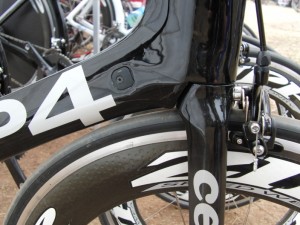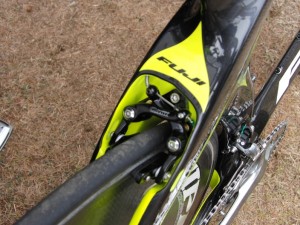The Cervelo P4, part 2: What I learned from Phil White
I had the good fortune of sharing some beers and nachos at Lulu’s with the Cervelo crew including co-founder Phil White. Phil is a great guy and put up with my lengthy line of bike-geek questions. I wanted to get to the bottom of the P4 design and how it stacks up versus the P3 and P2. 
One thing is clear – these guys simply try to make the best product possible, no bull. They are passionate about what they do – it seems to be more about breaking new barriers in design than about selling something. In the 2 years spent developing the P4 in the wind tunnel, they tried EVERYTHING. In my previous article I questioned why people would pay $2k more for the P4 versus the P3 – the improvements over the already dominant P3 look incremental to the naked eye. Well, here’s the reason: the reduction in drag from the the P4 to the P3 is the biggest jump they’ve ever made. The P3 and P2 are much closer to each other performance-wise than the P4 and the P3.
So the challenge will be to market it properly – Cervelo doesn’t slam other manufacturer’s products or publish cross-brand comparison data. That doesn’t mean they don’t know exactly where they stand. So they will have to market P4 versus P3, without actually killing P3 sales. Note that some of the details on the P4 will make it onto the P3 in coming years.
The unusual waterbottle/tool box that fills the lower triangle is a huge factor in the P4’s performance. However, it is the reason no one was riding one in Kona. Manufacturing delays.
I asked about the front brake – why use a conventional vs. behind the fork mount or something more radical. The answer? They tried all that stuff, and even have some patents for funky front brake setups including internal devices, aero brake shapes, etc. Within the design constraints of an operating, safe front fork, and within the overall system drag envelope of the front fork unit, nothing they tried in the tunnel made enough of a difference in drag to be worth it.
Some other interesting tidbits I picked up: When it comes to aero design all that matters is frontal area and shape. Ideally you reduce frontal area as much as possible yet maintain an aero-friendly shape. That means the proper aspect ratio (thickness vs width) that allows the air flow to reattach in a laminar fashion instead of going turbulent and creating a low-pressure drag area. For example, chain rings or disc brakes are very dirty flow-wise (very thin and broad). The Zipp lenticular chain ring and aero cranks really help there. This also points out that QR may have something with their offset frame design which pulls the flow away from the drive side.
Too, beware of aero looking shapes that end abruptly. If there is no finishing taper to help reattach the flow you get turbulence. So maybe the bullet bottle on the aero bars isn’t so great if it has a flat back. I also wonder about the Fuji D6’s rear brake shroud- looks great from the front but air flowing around it may suddenly find itself unattached and looking for somewhere to go – all that “looking” creates turbulence and drag. 
The bottom line: Everyone knows how great the P3 (and P2) is. Kona was absolutely infested with the things. In the P4 you have 2 more years of wind tunnel tinkering by arguably the best in the business. Is that worth the $2k upgrade? For many folks undoubtedly yes. Once they start racking up some results, people will believe if they don’t already. I am sure Kona will be littered with P4’s next year.

July 16, 2009 @ 10:54 am
Hi
Enjoyed your articles on the Cervelo P4. I have been thirsting for info on the model since last Dec when I put my order in. It finally arrived last week and I am looking forward to getting it on the road.
I am a Master B road racer in Nova Scotia, Canada and this is my first TT bike. My long term goal is to compete at the 2013 UCI Masters Road Race and TT Championships in Tirol, Austria so I figured why not get the ‘best’ now and train on it for the next four in preparation for my goal of winning the striped jersey at 50 yrs old.
Thanks again and I’ll let you know how it goes.
July 16, 2009 @ 11:06 am
Thanks Alan- my two training partners who have P4s really love them. They both had P3s and feel the P4 was an improvement. Congrats on your P4 and best of luck getting to Austria!
August 11, 2009 @ 1:29 pm
Todd
Questions about wheels for my P4.
I like the Zipp disc 900 and 808 front combination for two reasons; very fast and disc comes with powertap option that I definately want/need for training/racing. I can only find one other manufacturer that makes a rear disc with powertap and that is HED Jet Disc wheel which I would combine with a HED Tri Spoke. Are you aware of any others?
I read an article somewhere on the P4 that said with the way the rear chain stays are built on the P4 that a disc with a toroidal bulge isn’t required. Would using a HED disc take away from the P4 performance. What are your training partners using?
The HED wheel set is a couple of grand less than the Zipp set-up.
Thanks
Alan